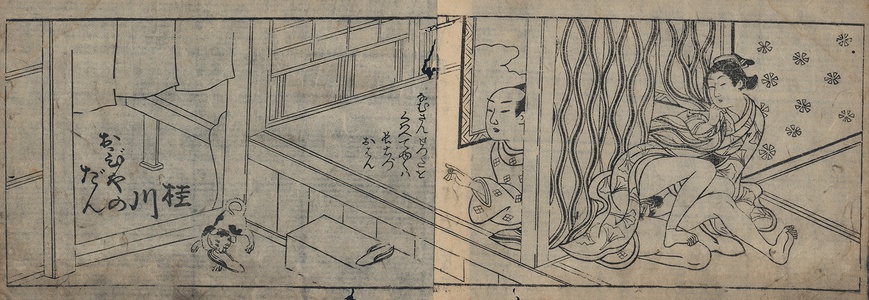| Method | Woodblock (nishiki-e) |
| Artist | Attributed to Tsukioka Settei (1726-1786) |
| Published | c. 1770 |
| Dimensions | Double horizontal Chubon [each sheet ~140 x 200 mm] |
| Notes |
A couple having sex either side of a curtain as a cat runs off with one of their sandals. This print is a perfect example of why shunga prints were known as "laughing pictures" through the inclusion of the foibles of life. The horizontal format of this print was popular in the late 1700s and was influenced by the shunga scroll painting formats where twelve images were made on a long horizontal roll. Shunga is the term used for the body of erotic imagery produced in Japan from 1600 to 1900. The term shunga means spring pictures, a euphemism for sex, and is one of several names for erotic material produced in Japan. Shunga took different formats: painted hand scrolls, painted books, printed books and albums, and sets of prints which were sometimes sold in wrappers. As prints they are one of the genres of ukiyo-e, or Floating World prints, which also include fukeiga (landscape prints), and bijin-ga (prints of beautiful women). Most of the major ukiyo-e artists produced shunga material at some point during their careers, including Utamaro (who produced more erotic books than non-erotic books), Hokusai, and Hiroshige. Produced at the same time as the introduction of full colour woodblock printing, shunga prints and books were made using the most lavish and complicated printing techniques, including gauffrage, metallic inks, mica, complicated printed patterns, and multicolour printing using a high number of different colours. Although prolific in its number and variety, shunga should be seen as more representative of the ideals of the ukiyo, with its emphasis on mutual pleasure, rather than as an accurate representation of Japanese attitudes and practices of sexuality. Shunga present an invitation to pleasure through the bliss of lovemaking and though largely heteronormative, they portray the full gamut of couplings, married or otherwise, often surrounded by lavish settings and objects of pleasure. Tsukioka Settei (1726-1786) was a ukiyo-e artist from the Ōmi province and lived and worked mainly in Osaka. An influential figure in the Kamigata, the area of western Japan that included Kyoto and Osaka, and seen as equally important as Sukenobu. Seetei studies painting in the style of the Kano school. Originally he focused on designing illustrations for woodblock illustrated books. He was a master of shunga and his work was rumoured to have the power to prevent fire. Many of his books were parodies of educational books for women which has the underlying theme that women should gain pleasure from sex. Ex. Col.: Peter Darach Condition: Overall toning to paper, worm hole top centre left near central join of sheets, worm holes in central left and right margins not affecting the printed image, some soiling lower right and left corners, watermarks upper left and right margins and just into the image. |
| Framing | unmounted |
| Price | £150.00 |
| Stock ID | 53262 |

